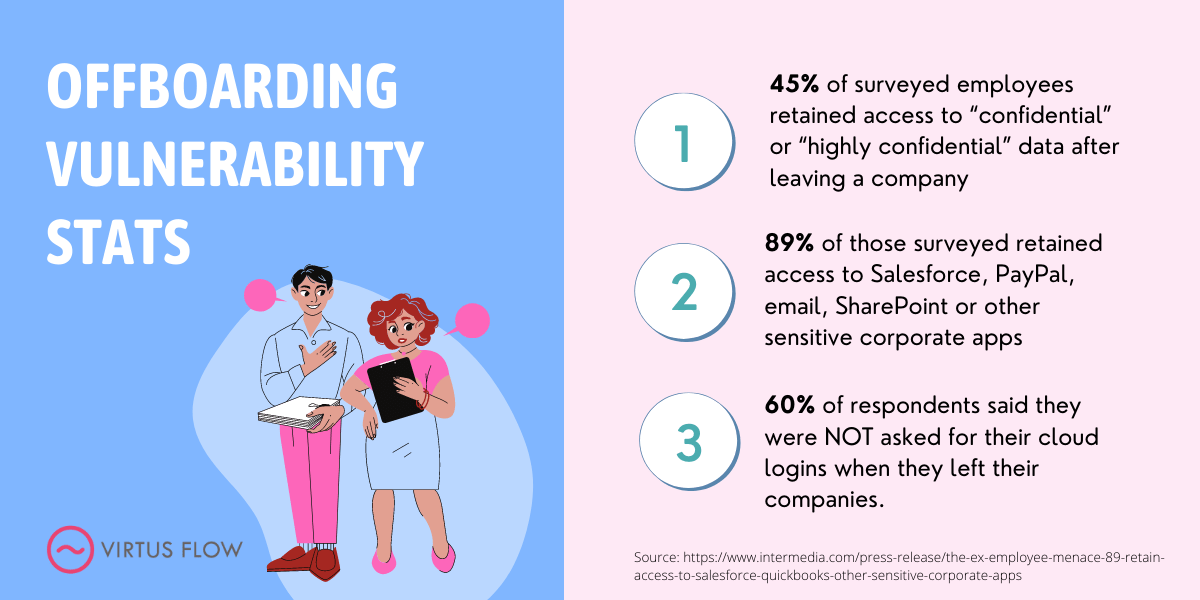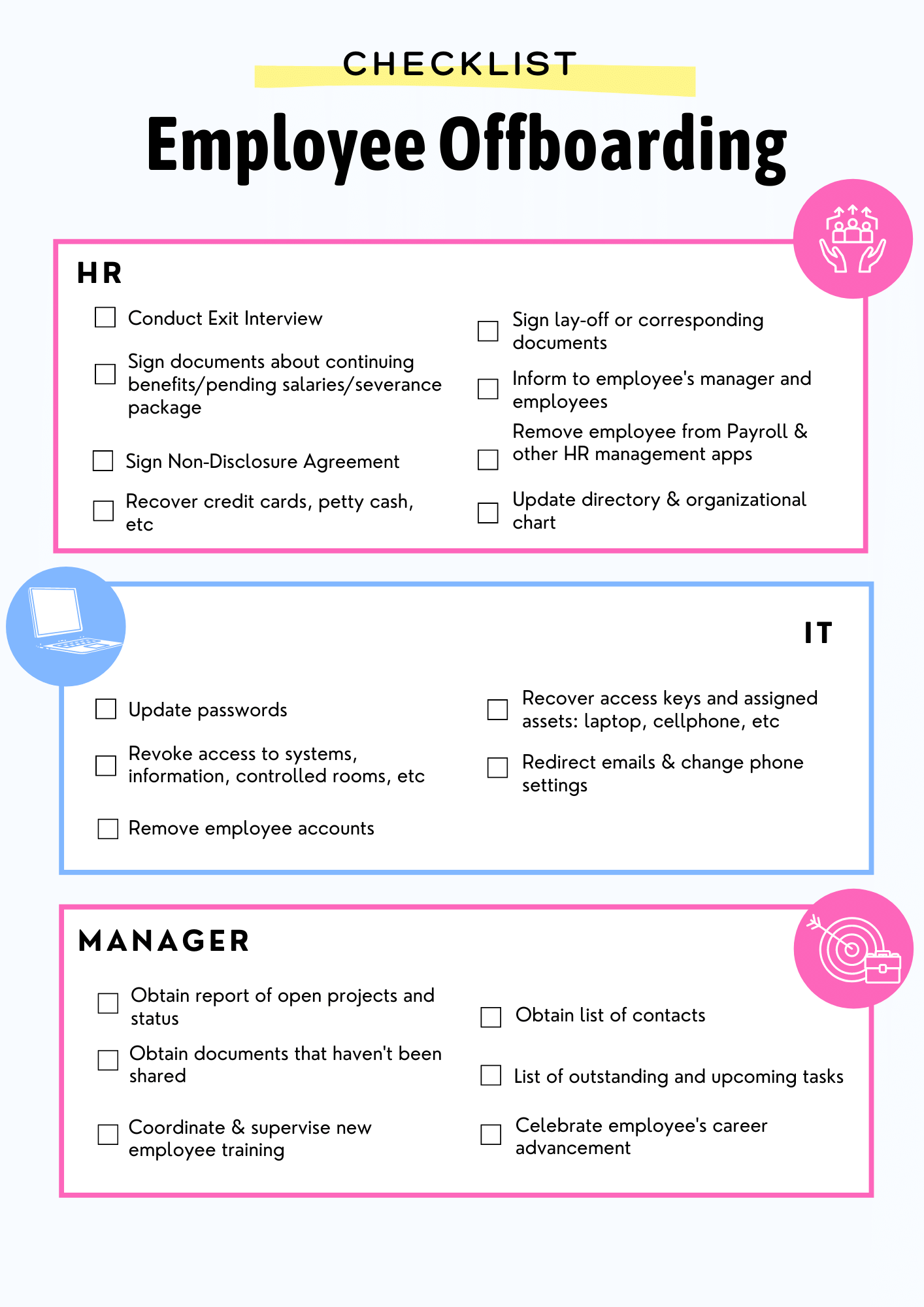Employee offboarding is “the process that leads to the formal separation between an employee and a company through resignation, termination, or retirement.” (Bamboo HR)
The entire process is vital to keeping your company secure, protected, and safe. But it is often overlooked or not handled correctly, which can lead to trouble down the road.
Why is it so important and what are the right steps to take? Let’s dig in.
Why Your Employee Offboarding Matters
» Simply put: it’s convenient for you!
One the most serious consequences of poor offboarding can lead to serious company vulnerabilities, such as data breach and unauthorized access to confidential information.

Share this Image On Your Site
In addition, when an employee leaves your company in a positive way, they will likely speak highly of your company and even send customers or potential employees your way.
If they leave with a bad taste in their mouth, they may even advise people against using your services. Or even worse, depending on how bad you two left terms, they can take it to social media. We all know the effect that can have.
» To prevent the last scenario, one of the main goals of offboarding is to turn all negatives into positives.
In the long run, preserving your organization’s reputation is important for both acquisition and retention. Proper offboarding will reduce the chance of misunderstandings after the employee leaves — which can affect your company’s culture and your bottom line.
In the case of retirement or moving on to a ‘better’ job, losing extremely tenured or experienced employees can seem like a tough challenge to overcome. With the right offboarding plan, however, you will be able to gather all of the key knowledge they have and ensure a smooth transition as they depart.
Learn how to reduce your Offboarding Vulnerability with automated workflows!
What is Involved in an Employee Offboarding Process?
When an employee leaves, there are vital steps to take. From properly communicating the departure with the rest of the team to changing passwords, collecting credit cards, transferring access, and performing an exit interview.
If an employee leaves on their own terms, it is best to have them create a list of their daily duties, write down all passwords, and give their manager access to all information. This will lead to a smoother transfer of knowledge and duties when a new employee starts.
If an employee doesn’t leave on their own terms, however, there are different steps to take.
They must still hand over all passwords, give up credit cards and car keys, as well as perform any asset transfers required. (Find details in Offboarding Checklist)
There may be some backlash from the employee in this case, so it is always best to go through your Human Resources department when requesting these pieces.
If this process is not handled correctly, the departing employee can leave with extremely valuable company information. For this reason you will need to control access to information smartly, but this is a topic for another day.
Yes, credit cards can be canceled and passwords can be changed, but there is always a risk that the ex-employee can do severe damage to the company or its reputation if the proper steps aren’t taken.
» Severe risks, such as data loss, confidentiality, data, and security breaches, and wasted spend are serious possibilities when an employee offboarding process is not handled correctly.
Learn how to automate your Offboarding Process in a simple and fast way!
How to Offboard an Employee the Right Way
When determining the right steps to take when employees leave, it is best to conduct an employee offboarding checklist. Just follow these steps to check every part of the process.
Step 1: Oversee an exit interview
Step 2: Disallow email forwarding and data sharing
Step 3: Remove access to all data, applications, and services
Step 4: Create new passwords — both for the employee’s personal information and for shared passwords for their team
Step 5: Reassign daily duties and monthly agendas to current employees
Step 6: Make every attempt to end on a good note
Why to Automate Your Employee Offboarding
As you can see above, there are quite a few items to check when an employee leaves a company. The best way to ensure that there are no missed steps when an employee exits is to create automatic offboarding workflows.
With offboarding automation you can:
-
- Create rules and logic to ensure each step is handled by the the right person at the right time
- Grant and deny access to information
- Collect passwords and sensitive information in a secure manner
- Set reminders to change passwords and update task owners
- Set an standard offboarding process following best practices
- Ensure a smooth transition by transferring daily duties to other team members
Conclusion
Employee offboarding is important for both team members and organizations.
When you utilize the right workflow automation solution, you ensure that your offboarding plan works to the fullest.
Company assets stay in-house, knowledge transfer is completed, and the employee’s lifecycle comes to a fulfilling end.
Turnover is never easy, but when you use Virtus Flow’s offboarding workflows, you can guarantee a smoother and controlled employee transition.





